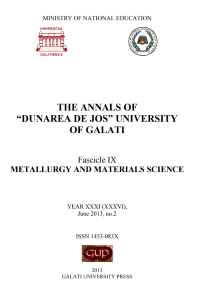Dental Metals and Alloys Characterization
Abstract
Metals and alloys in dentistry have seen remarkable progress due to their biocompatibility and deepen research on the application of advanced technologies to improve surface properties by controlling interactions material - environment in the mouth. Biocompatibility of metals is a consequence of the presence of surface oxide layer. Chemical properties and therefore chemical processes determine precisely this interface oxide layer and not the metal itself. Biocompatibility would be perfect without any biomaterial - tissue interactions and could be assured by a completely inert biomaterial, which does not exist at this time. Titanium and its alloys provide strength, rigidity, and ductility similar to those of other dental alloys. Whereas, pure titanium castings have mechanical properties similar to Type III and Type IV gold alloys, some titanium alloy castings, such as Ti-6Al-4V and Ti-15V, have properties closer to Ni-Cr and Co-Cr castings with the exception of lower modulus. Co-Cr alloys are alloys nenobile group, developed as an alternative to noble alloys, which have become very expensive, inaccessible and limited resources. Modern alloys based on Co-Cr, due to its superior mechanical and costeffective price noble alloys have replaced the classic class IV in technology (metalpolymer) and modern (metal and metal-ceramic composite). Co-Cr alloys have advantages related to high modulus (250GPa) than type IV gold alloys (70-100GPa) but they maintain their rigidity, which means that all items may have minimum thickness metal frame.
This article presents a few considerations and results of studies regarding the biological behavior and corrosion resistance of the commercially pure titanium (CP Ti), titanium alloys (e.g. Ti6Al4V), in comparison with other alloys (stainless steel, Co-Cr alloys) used in prosthetic or orthodontic implant technology.
Downloads
References
[2]. ASM Handbook Committee - Metals Handbook-Corrosion of Metallic Implants and Prosthetic Devices, vol. 13, ninth ed., American Society for Metals, Metals Park, 1987.
[3]. Christoph Leyens, Manfred Peters - Titanium and Titanium Alloys-Fundamentals and Applications, Ed. WILEY-VCH, pg. 4-16, 2004.
[4]. Gotman I. - Characteristics of metals used in implants, J Endourol (1997), 11(6):383-9.
[5]. Claudia Fleck - Dietmar Eifler - Corrosion, fatigue and corrosion fatigue behaviour of metal implant materials, especially titanium alloys, International Journal of Fatigue 32 (2010) 929–935.
[6]. M. Karthega, V. Raman, N. Rajendran - Influence of potential on the electrochemical behaviour of b titanium alloys in Hank’s solution, Acta Biomaterialia 3 (2007) Elsevier, p. 1019–1023.
[7]. H.J. Rack, J.I. Qazi - Titanium alloys for biomedical applications, Materials Science and Engineering C 26 (2006) Elsevier, p. 1269 – 1277.
[8] Ghiban, B. - Metallic Biomaterials - Ed. Printech Bucuresti (1999).
[9]. ***, Orthodontic Mini implants, Leone Clinical procedure for positioning.



